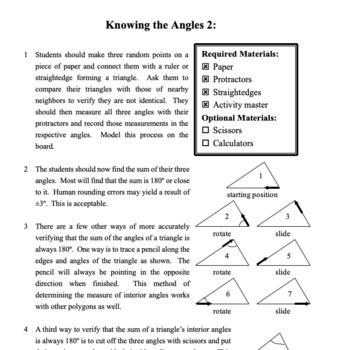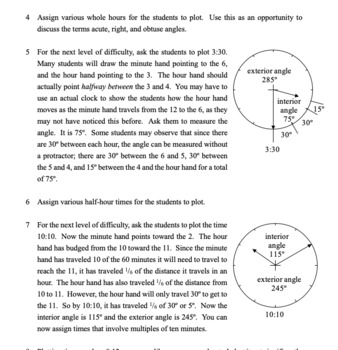Knowing the Angles: Three Geometry Activities in One!
Teacher to Teacher Press
482 Followers
Grade Levels
7th - 10th
Subjects
Resource Type
Standards
CCSS7.G.B.5
CCSS8.G.A.2
CCSS8.G.A.4
CCSS8.G.A.5
CCSS8.G.B.7
Formats Included
- PDF
Pages
31 pages
Teacher to Teacher Press
482 Followers
Description
This middle school and high school resource contains three great geometry activities in one coupled with Common Core alignment and research tips. Answer keys are included.
- Knowing the Angles: Versions 1 & 2 — Students will construct polygons and find their interior angles. They will discover patterns that help them make predictions about other polygons. Multiple options allow for both younger and older students to participate and to understand the concepts. They will begin by using tangrams and then graduate to more sophisticated applications as they generalize their discoveries.
- Clock Angles — Students will model given times on a clock face and find the interior and exterior angles formed by the hands. They will use protractors and ratios to measure the angles and work with proportional reasoning.
- Geoboard Squares — Students will explore the different ways to build squares on a geoboard in this engaging and intriguing exploration.They can use the Pythagorean Theorem to prove which squares can be built on the grid and which squares cannot.
Total Pages
31 pages
Answer Key
Included
Teaching Duration
1 Week
Report this resource to TPT
Reported resources will be reviewed by our team. Report this resource to let us know if this resource violates TPT’s content guidelines.
Standards
to see state-specific standards (only available in the US).
CCSS7.G.B.5
Use facts about supplementary, complementary, vertical, and adjacent angles in a multi-step problem to write and solve simple equations for an unknown angle in a figure.
CCSS8.G.A.2
Understand that a two-dimensional figure is congruent to another if the second can be obtained from the first by a sequence of rotations, reflections, and translations; given two congruent figures, describe a sequence that exhibits the congruence between them.
CCSS8.G.A.4
Understand that a two-dimensional figure is similar to another if the second can be obtained from the first by a sequence of rotations, reflections, translations, and dilations; given two similar two-dimensional figures, describe a sequence that exhibits the similarity between them.
CCSS8.G.A.5
Use informal arguments to establish facts about the angle sum and exterior angle of triangles, about the angles created when parallel lines are cut by a transversal, and the angle-angle criterion for similarity of triangles. For example, arrange three copies of the same triangle so that the sum of the three angles appears to form a line, and give an argument in terms of transversals why this is so.
CCSS8.G.B.7
Apply the Pythagorean Theorem to determine unknown side lengths in right triangles in real-world and mathematical problems in two and three dimensions.





